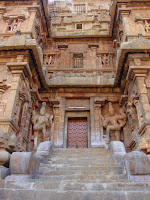Karnataka is one of the finest treasure house of India's Culture & Heritage.
Another majestic Dravidian architecture can be seen at Belur (40 kms from Hassan district), built by the then Hoysala ruler Vishnuvardhan in 1117 AD (12’th century) in commemoration of his vistory over the Cholas.
What’s more attracting than the visually stunning temple of Shri Chennakeshava (Handsome Vishnu) and Raya-gopuram, is the breath-taking sculptures surrounding the main shrine.



Though Vishnuvardhan started this construction, it was later completed by his grandson Veera Ballala and it took 103 years for completion.
The artisans have so well performed their job that you “see” perfection, patience, discipline and love in every inch of the stone. You see intricate sulptures and friezes on the temple façade, the entrance, the ornate pillars, ceiling & central dome, everywhere!
The workmanship of the famous artisans of the era – Janakachari, Danakachari and others is adorable.



The material used in both Belur and Halebeedu temples is Soap Stone, which is soft and helps ease in carving. Over prolonged exposure to atmosphere, its gets harder.
This perfect art of stone carvings called “Shilabalike” talks of the glorious era. It portraits different images of women in different postures, engaged in different tasks. For ex – Darpana-Sundari (lady with a mirror), sensuous dancers, Shuka-bhasini (lady talking to parrot), etc.
One more eye catching images would be that of a man killing a tiger. This infact is the Hoysala logo. The Hoysala dynasty was founded by a young, brave warrior named Sala, who had killed a tiger with bare hands and hence the symbol.






Layers of well carved images of Lions(power), Elephants(strength), Horses(speed), Flowers(beauty), episodes from Indian epics like Ramayana and Mahabharatha can be seen as you take a walk in the premises.




Halebeedu (Old Habitat, translated in Kannada) which is around 20 kms from Belur also offers sight to the rich heritage of Hoysala dynasty. Initially named as Dwarasamudra, this capital was invaded by Muslim rulers from the north, you can see lot of damages in the temple premises of Halebeedu.
The main diety is Hoysaleshwar (Shiva) and also has one of the biggest Nandi statues in the country.


Somnathpura (near Mysore) too shares the richness of Hoysala architecture and is equally beautiful as Belur and Helebeedu.
Small river streams join and together they run into the sea… the same way - different languages, religions & teachings, food, tradition, history, values, clothing… all culminate to just one – that’s our lovely mother land INDIA.
















